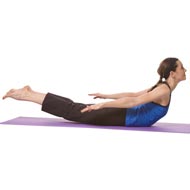- Aromatherapy (36)
- Benefits of Yoga (282)
- Home Remedies (1087)
- massage therapy (9)
- Preventive Therapy (135)
- Running (41)
- Skin Care (15)
- Stress Relief (25)
- Stretching (5)
- walking (33)
- Womens Health (14)
- Yoga Benefits for Pregnant Women (16)
- Yoga Benefits for Students (3)
- Yoga for Children (11)
- Yoga for Holistic Living (37)
- Yoga for Midlife Crisis (3)
- Yoga for Senior Citizens (2)
- Yoga for the Workplace (1)
- Yoga Health Tips (185)
- Yoga Practice during Menstruation (5)
Yoga Exercises For Healthy Knees

Situated at the center of the human legs, your knees are hard-working shock absorbers used to support and move. They are made up of bones, ligaments, cartilage and tendons. Yoga practices keep the knees healthy by stretching and strengthening the ligaments, cartilage and tendons surrounding the joints that support our weight. These Yoga poses even help mobilize the knee joints by rectifying the misalignment which occurs when the muscles are too tight.
If you have no bone to bone stability or unstable joints, your knees become sensitive and, subsequently, vulnerable to misalignment. So also, knee injuries as a result of strenuous activities, sports, sprains, arthritis or osteoarthritis, strains, bursitis, or tendonitis can be major causes of discomfort. If you wish to avoid such knee problems see that you warm up and cool down enough, stretch well and are in good form during physical activity. Being overweight or Obesity is another major risk factor. With regard to athletes, knee injuries can put an end to their careers since joint mobility is vital to all sports. It normally takes around three weeks to six months for recovery before your injured or damaged knees can function well again.
Yoga is a great way to treating knee problems. Here are some Yoga recommendations for knee problems. Asanas (poses) – They help in restoring joint flexibility re-strengthen the muscles. If you do them consciously, with proper alignment of the leg joints and bones, they will definitely help strengthen your knees and make them far less receptive to injury
Also remember, pushing yourself too far is hardly the best way to recovery. Yoga should be practiced mainly during the recovery period, in case of injuries, and not when the injury is still fresh.
Yoga Asanas For Knee Problems
Here are some Yoga asanas (poses) that will help you get the best out of your knees, making them more flexible, stronger and less prone to problems of any sort.
- Shavasana (Corpse Pose) – This pose is the classic relaxation Yoga pose and should be practised in between or at the end of an asana session as a final relaxation. While Shavasana appears deceptively simple, it may actually be rather difficult to perform.
- Pawanmuktasana (Wind Relieving Pose) – The term Pawanmuktasana is derived from the Sanskrit word 'Pawana' meaning air or wind and 'Mukta' meaning release or freedom. So this asana (pose) works mainly on your digestive system, particularly to help eliminate excess gases from your stomach. It is also excellent for the knees.
- Stand Spread Leg Forward Fold – This will help stretch and strengthen your spine, and legs. Those suffering from lower back problems should, however, avoid doing this.
- Trikonasana (Triangle Pose) – This pose is great for developing overall posture for stretching and strengthening the knees, calves and hamstrings.
- Bhujangasana (Cobra Pose) – This pose strengthens the muscles in your back and arms and increases spinal flexibility. It is also highly effective in stretching the muscles of the knees.
- Single and Double Leg Raises – These are done to prepare your body for other poses. They are beneficial for the lower back muscles, legs and abdominal region.
- Shalabhasana (Locust Pose) – While Bhujangasana (Cobra Pose) works mainly on your upper back, Shalabhasana targets your lower back. It also helps strengthen your arms, legs and abdominal area.
- RSS Feeds -
- All posts
- All comments
- Sacroiliac joint exercises The sacroiliac joint is the joint that connects the spine and the pelvis. The...
- Exercises for hyperextended knee Whenever the knee flexes in the opposite direction and extends beyond the straig...
- Fitness Exercises When Pregnant Backaches are a common problem during pregnancy. The cause for backaches can ...
- Treat back pain with exercise during pregnancy Back pain during pregnancy is a common occurrence. The changes to a woman&rsq...